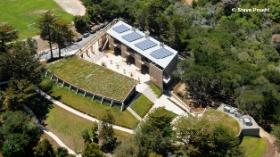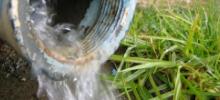Math questions / Water runoff
What are the soil conditions and the native plants in a school's site?
Why is water runoff on a site an important idea when designing sustainable buildings?
What happens to the rainwater that falls on a site? If the site is completely permeable (turf, vegetation), all the rain will soak into the ground. If the site is completely impermeable roof, pavement), it will shed all water run off into the sewer system or waterways. These extreme situations to not usually occur becuase most materials and groundcover absorb some of the precipitation and shed the rest. The runoff coefficient measures the percent of water that drains off. The higher the coefficient, the greater the amount of water will run off. A runoff coefficient of 0.30, for example, means that 30% of the water that falls on the material will run off, while 70% will be absorbed.
Landscape architects typically want to minimize the amount of rainwater that runs off the site, because in most cities rainwater drains directly into the sewer system where it mixes with untreated sewage that must be processed and cleaned. A permeable landscape, on the other hand, will allow the rainwater that naturally falls to support the plant life growing there.
The Typical Runoff Coefficient chart below determines the number of cubic inches of water that runs off each of the following during a rainfall of 1 inch. Unless a slope is given, assume the site is flat. Note that 1 acre = 43,560 square feet.

1a.
How many cubic inches of water will run off a 1 acre site covered by a building with an asphalt roof?
1b.
How many cubic inches of water will run off a 1 acre site covered with gravel?
1c.
How many cubic inches of water will run off a 1 acre site covered with vegetation?
1d.
How many cubic inches of water will run off a 1 acre site half covered by asphalt and half covered by turf?
2.
During a 1†rainfall, how much more water runs off an acre of turf with a steep slope than an acre of turf that is flat?
3.
An architect is trying to decide whether to choose ordinary asphalt or porous asphalt to cover a parking lot. The porous asphalt produces what percentage of the runoff that the regular asphalt produces?
The library and cafeteria of the Nueva School each have a green roof that measures 6†thick. According to the chart above, the runoff coefficient for a 6†green roof equals 0.30. Together, these roofs cover an area of 10,900 sq ft. For problems #4 - #7, consider a storm where 1†of rain falls.

4.
What percent of rainfall is absorbed by the green roof?
5.
If 1 cubic inch ≈ 0.004329 gallons, how many gallons of water fall on the combined roofs during the storm?
6.
How many gallons run off the two roofs combined?
7.
How much less water would run off the roofs if, instead of green roofs that measuring 6 inches thick, the architects had decided to use a roof that measures 22 inches thick?
For problems #8 - #10, consider the roof of the classroom building at the Nueva School, which contains photovoltaic (solar) panels. These panels are placed over an impermeable roof surface which measure 16,100 square feet.

8.
What does “impermeable†mean in terms of runoff?
9.
In a 1†rainstorm, how many gallons of water would run off the classroom building? Note that 1 cubic inch ≈ 0.004329 gallons.
10.
Describe one benefit and one disadvantage of covering the roof of the classroom building with photovoltaic panels.

